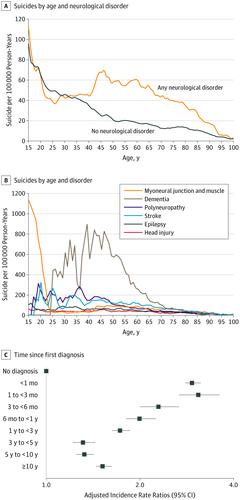Our official English website, www.x-mol.net, welcomes your feedback! (Note: you will need to create a separate account there.)
Association Between Neurological Disorders and Death by Suicide in Denmark
JAMA ( IF 120.7 ) Pub Date : 2020-02-04 , DOI: 10.1001/jama.2019.21834 Annette Erlangsen 1, 2, 3, 4 , Egon Stenager 5, 6, 7, 8 , Yeates Conwell 9 , Per Kragh Andersen 10 , Keith Hawton 11, 12 , Michael Eriksen Benros 13 , Merete Nordentoft 1, 13, 14 , Elsebeth Stenager 3, 7
JAMA ( IF 120.7 ) Pub Date : 2020-02-04 , DOI: 10.1001/jama.2019.21834 Annette Erlangsen 1, 2, 3, 4 , Egon Stenager 5, 6, 7, 8 , Yeates Conwell 9 , Per Kragh Andersen 10 , Keith Hawton 11, 12 , Michael Eriksen Benros 13 , Merete Nordentoft 1, 13, 14 , Elsebeth Stenager 3, 7
Affiliation

|
Importance
Neurological disorders have been linked to suicide, but the risk across a broad spectrum of neurological disorders remains to be assessed. Objectives
To examine whether people with neurological disorders die by suicide more often than other people and to assess for temporal associations. Design, Setting, and Participants
Nationwide, retrospective cohort study on all persons 15 years or older living in Denmark, from 1980 through 2016 (N = 7 300 395). Exposures
Medical contact for head injury, stroke, epilepsy, polyneuropathy, diseases of myoneural junction, Parkinson disease, multiple sclerosis, central nervous system infections, meningitis, encephalitis, amyotrophic lateral sclerosis, Huntington disease, dementia, intellectual disability, and other brain diseases from 1977 through 2016 (n = 1 248 252). Main Outcomes and Measures
Death by suicide during 1980-2016. Adjusted incidence rate ratio (IRRs) were estimated using Poisson regressions, adjusted for sociodemographics, comorbidity, psychiatric diagnoses, and self-harm. Results
Of the more than 7.3 million individuals observed over 161 935 233 person-years (49.1% males), 35 483 died by suicide (median duration of follow-up, 23.6 years; interquartile range, 10.0-37.0 years; mean age, 51.9 years; SD, 17.9 years). Of those, 77.4% were males, and 14.7% (n = 5141) were diagnosed with a neurological disorder, equivalent to a suicide rate of 44.0 per 100 000 person-years compared with 20.1 per 100 000 person-years among individuals not diagnosed with a neurological disorder. People diagnosed with a neurological disorder had an adjusted IRR of 1.8 (95% CI, 1.7-1.8) compared with those not diagnosed. The excess adjusted IRRs were 4.9 (95% CI, 3.5-6.9) for amyotrophic lateral sclerosis, 4.9 (95% CI, 3.1-7.7) for Huntington disease, 2.2 (95% CI, 1.9-2.6) for multiple sclerosis, 1.7 (95% CI, 1.6-1.7) for head injury, 1.3 (95% CI, 1.2-1.3) for stroke, and 1.7 (95% CI, 1.6-1.8) for epilepsy. The association varied according to time since diagnosis with an adjusted IRR for 1 to 3 months of 3.1 (95% CI, 2.7-3.6) and for 10 or more years, 1.5 (95% CI, 1.4 to 1.6, P < .001). Compared with those who were not diagnosed with a neurological disorder, those with dementia had a lower overall adjusted IRR of 0.8 (95% CI, 0.7-0.9), which was elevated during the first month after diagnosis to 3.0 (95% CI, 1.9-4.6; P < .001). The absolute risk of suicide for people with Huntington disease was 1.6% (95% CI, 1.0%-2.5%). Conclusions and Relevance
In Denmark from 1980 through 2016, there was a significantly higher rate of suicide among those with a diagnosed neurological disorder than persons not diagnosed with a neurological disorder. However, the absolute risk difference was small.
中文翻译:

丹麦神经系统疾病与自杀死亡之间的关联
重要性 神经系统疾病与自杀有关,但广泛的神经系统疾病的风险仍有待评估。目的 研究神经系统疾病患者是否比其他人更常死于自杀,并评估时间关联。设计、设置和参与者 1980 年至 2016 年期间在丹麦的所有 15 岁或以上人群的全国性回顾性队列研究(N = 7 300 395)。头部外伤、中风、癫痫、多发性神经病、肌神经接头疾病、帕金森病、多发性硬化症、中枢神经系统感染、脑膜炎、脑炎、肌萎缩侧索硬化症、亨廷顿病、痴呆、智力障碍和其他脑部疾病的医疗接触1977 年至 2016 年(n = 1 248 252)。主要结果和措施 1980-2016 年自杀死亡。使用泊松回归估计调整后的发病率比 (IRR),并根据社会人口统计学、合并症、精神病诊断和自我伤害进行调整。结果 在超过 161 935 233 人年(49.1% 男性)观察到的超过 730 万人中,35 483 人死于自杀(中位随访时间为 23.6 年;四分位距为 10.0-37.0 岁;平均年龄为 51.9 岁)年;SD,17.9 年)。其中,77.4% 为男性,14.7% (n = 5141) 被诊断患有神经系统疾病,相当于每 100 000 人年 44.0 例的自杀率,而未诊断出患有神经系统疾病的个体为 20.1/100 000 人年一种神经系统疾病。与未诊断出的患者相比,被诊断出患有神经系统疾病的人的调整后 IRR 为 1.8(95% CI,1.7-1.8)。肌萎缩侧索硬化的过度调整 IRR 为 4.9(95% CI,3.5-6.9),亨廷顿病为 4.9(95% CI,3.1-7.7),多发性硬化为 2.2(95% CI,1.9-2.6),1.7(头部损伤为 95% CI,1.6-1.7),中风为 1.3(95% CI,1.2-1.3),癫痫为 1.7(95% CI,1.6-1.8)。相关性因诊断后时间而异,调整后的 IRR 为 1 至 3 个月(95% CI,2.7-3.6)和 10 年或更长时间,1.5(95% CI,1.4 至 1.6,P < .001) . 与未诊断为神经系统疾病的患者相比,痴呆患者的总体调整后 IRR 较低,为 0.8(95% CI,0.7-0.9),在诊断后的第一个月内升高至 3.0(95% CI,1.9) -4.6;P < .001)。亨廷顿病患者的绝对自杀风险为 1.6%(95% CI,1.0%-2.5%)。结论和相关性 在丹麦,从 1980 年到 2016 年,诊断出神经系统疾病的人的自杀率明显高于未诊断出神经系统疾病的人。然而,绝对风险差异很小。
更新日期:2020-02-04
中文翻译:

丹麦神经系统疾病与自杀死亡之间的关联
重要性 神经系统疾病与自杀有关,但广泛的神经系统疾病的风险仍有待评估。目的 研究神经系统疾病患者是否比其他人更常死于自杀,并评估时间关联。设计、设置和参与者 1980 年至 2016 年期间在丹麦的所有 15 岁或以上人群的全国性回顾性队列研究(N = 7 300 395)。头部外伤、中风、癫痫、多发性神经病、肌神经接头疾病、帕金森病、多发性硬化症、中枢神经系统感染、脑膜炎、脑炎、肌萎缩侧索硬化症、亨廷顿病、痴呆、智力障碍和其他脑部疾病的医疗接触1977 年至 2016 年(n = 1 248 252)。主要结果和措施 1980-2016 年自杀死亡。使用泊松回归估计调整后的发病率比 (IRR),并根据社会人口统计学、合并症、精神病诊断和自我伤害进行调整。结果 在超过 161 935 233 人年(49.1% 男性)观察到的超过 730 万人中,35 483 人死于自杀(中位随访时间为 23.6 年;四分位距为 10.0-37.0 岁;平均年龄为 51.9 岁)年;SD,17.9 年)。其中,77.4% 为男性,14.7% (n = 5141) 被诊断患有神经系统疾病,相当于每 100 000 人年 44.0 例的自杀率,而未诊断出患有神经系统疾病的个体为 20.1/100 000 人年一种神经系统疾病。与未诊断出的患者相比,被诊断出患有神经系统疾病的人的调整后 IRR 为 1.8(95% CI,1.7-1.8)。肌萎缩侧索硬化的过度调整 IRR 为 4.9(95% CI,3.5-6.9),亨廷顿病为 4.9(95% CI,3.1-7.7),多发性硬化为 2.2(95% CI,1.9-2.6),1.7(头部损伤为 95% CI,1.6-1.7),中风为 1.3(95% CI,1.2-1.3),癫痫为 1.7(95% CI,1.6-1.8)。相关性因诊断后时间而异,调整后的 IRR 为 1 至 3 个月(95% CI,2.7-3.6)和 10 年或更长时间,1.5(95% CI,1.4 至 1.6,P < .001) . 与未诊断为神经系统疾病的患者相比,痴呆患者的总体调整后 IRR 较低,为 0.8(95% CI,0.7-0.9),在诊断后的第一个月内升高至 3.0(95% CI,1.9) -4.6;P < .001)。亨廷顿病患者的绝对自杀风险为 1.6%(95% CI,1.0%-2.5%)。结论和相关性 在丹麦,从 1980 年到 2016 年,诊断出神经系统疾病的人的自杀率明显高于未诊断出神经系统疾病的人。然而,绝对风险差异很小。


























 京公网安备 11010802027423号
京公网安备 11010802027423号